
Are you tired of weeding your garden, only to find that the same pesky plants keep popping up? Well, what if we told you that one of those so-called weeds might actually be your new best friend? Enter chickweed – a humble little herb that’s been overlooked for far too long. In this article, we’ll explore the fascinating world of chickweed, from its uses in traditional medicine to its surprising culinary potential. So, why should you keep reading? Because chickweed is more than just a nuisance – it’s a versatile and nutritious plant that deserves a spot in your garden (and your kitchen).
Chickweed (Stellaria media) is a wild plant in the Carnation family. It makes an appearance in early spring and dies back once temperatures warm into the 90s. They may make an appearance in late fall as temperatures cool again.
Chickweed is a wild edible plant that is highly nutritious and rather tasty. Some people say it tastes like cornsilk. It contains many vitamins and minerals we consider essential. Chickweed contains beta-carotene, ascorbic acid, gamma-linolenic acid, niacin, thiamin, riboflavin, Vitamin C, calcium, magnesium, copper, zinc, selenium, and potassium.
Identification
Chickweed is fairly easy to identify once you know what you are looking for. It has small leaves that grow each other opposite on the stem. The tiny white flowers have five petals that are deeply cleft so that it may look like the flowers have 10 petals. There is a line of fine hairs that grow along only one side of the stem. This line of hairs alternates at each set of flowers. The stem will stretch when pulled and the stem doesn’t release a milky sap when separated.
There is only one Chickweed look-alike to be concerned with. Scarlet Pimpernel looks very similar to chickweed until it flowers. The flowers of scarlet pimpernel are reddish-orange colored. Scarlet Pimpernel is toxic so if you are unsure about your identification it is best to wait until the plant flowers to be sure.

Chickweed Edible Uses
The entire Chickweed plant above ground is edible, including the leaves, flowers, stems, and even the seeds. It has the common name chickweed because chickens love it. It is one of the first plants to begin growing in the spring, while the temperatures are too cold for other plants. This makes chickweed a sought-after early spring edible wild plant.
Chickweed can be eaten raw in salads mixed with other leafy greens. To harvest the plant for a salad simply grab a handful of the plants and snip the tops off with a pair of scissors. Chop the leaves, stems, and flowers finely and add them to your salad.
Chickweed can be cooked and used in the same ways you cook other leafy greens, such as spinach. Many people say the taste is similar to spinach but with a different texture.
However you decide to eat it, chickweed is both tasty and nutritious. It is a good source of fiber and even contains a fair amount of protein.
Chickweed Medicinal Uses
This plant has an array of plant-produced chemical compounds that make it useful for our health. These include flavonoids, saponins, phytosterols, and Vitamin C. Some of the compounds in this amazing little plant are things you should try and get more of in your diet already. We don’t get nearly enough of many vitamins and minerals eating our Western diet of processed foods.
Although there isn’t a significant amount of research studies available on the medicinal effects of chickweed, there are some traditional herbal uses that are believed to be effective.
Uses For Skincare
My favorite use for this plant in my natural medicine chest is for use on the skin. It is really great at helping to heal small cuts and other wounds, for burns, insect bites, rashes, and other skin irritations. Research does show that it has anti-inflammatory, emollient, and anti-viral properties.
I normally make an infused oil from the leaves and use it anytime I get a sting or bite from such things as wasps, ticks, and chiggers. It helps relieve the itch and sting from the bites. It also helps to reduce inflammation and swelling in the area.

To make an infused oil you simply collect the leaves and stems, cut them up, and place them in a heat-resistant jar such as a Mason jar. Cover the leaves completely with a carrier oil such as sweet almond or grapeseed oil, and put the lid on the jar. Place this in a dark cupboard for 4-6 weeks. Be sure and come by and give it a good shake every couple of days to make sure all the plant material comes in good contact with the oil. Once infused for 4-6 weeks you can use the oil as-is or use it to make soothing skin salve using the procedure outlined below.
If you are in a hurry, you can make the infused oil using a crockpot that can be infused in 72 hours instead of 4-6 weeks. I outline this process in our article on dandelion skincare balm.
Making Chickweed Skin Salve
Once you have your infused oil you can make a balm or salve by melting beeswax and adding it to the infused oil in a double boiler. You don’t need to purchase a fancy double boiler. I simply use a quart jar in a saucepan about half full of water.
Measure the amount of infused oil you have and then melt about 1/4 cup of wax for every cup of oil. Place the wax into the double boiler and heat gently to melt the wax. Then add in your infused oil and continue heating until the wax is melted again. Once the mixture is stirred thoroughly together pour it into your storage jars and keep it in a cool dark place for 6 months to 1 year.
Good For Overall Health
Chickweed can support your health because it contains Vitamin C and Zinc, which can help support your immune system.
Since it contains calcium and magnesium it can help support those who don’t get enough calcium in their diet, which could help prevent osteoporosis and improve skeletal health.
Chickweed For Respiratory Health
Some of the compounds present in chickweed may have expectorant effects that can help when you have a chest cold or other ailments that cause stuffiness and coughs. It may help thin the phlegm your body produces when fighting a respiratory illness and help with your ability to cough it up.
May Help Reduce Pain and Inflammation
Homeopathic practitioners have long believed that these plants can reduce inflammation which causes pain in conditions such as arthritis and rheumatism. It also has been discussed as a digestive aid that might help with gut inflammation.
Precautions
Consuming large amounts may lead to upset stomach, nausea, diarrhea, and other digestive upsets. Consume only small amounts initially if you plan to consume chickweed until you see how your body reacts. This is a good rule for using any wild edible.
Some people may be sensitive and may develop a mild rash if it is used on the skin. When making infused herbal oils it is always a good idea to test it on a small patch of skin on the inside of the forearm. If you notice no redness or other irritation in the area, it is most likely safe for you to use.
Summary
Chickweed is an edible plant that also has some surprising uses medicinally to help with skin conditions and inflammation. Be sure and properly identify any wild plants you intend to consume.
FAQs:
Q: Why is chickweed a problem?
A: Chickweed can become problematic in lawns and gardens because it grows quickly and can choke out other plants.
Q: Is chickweed an invasive plant?
A: Chickweed is not considered an invasive plant, but it can spread quickly and become weedy if not properly controlled.
Q: Can chickweed be poisonous?
A: No, chickweed is not poisonous and is actually safe for human consumption.
Q: What does chickweed look like in your yard?
A: Chickweed has small, oval-shaped leaves and small white flowers. It can grow low to the ground and spread quickly.
Q: What is chickweed and what does it look like?
A: Chickweed is a common herb that is found in many parts of the world. It has small, oval-shaped leaves and small white flowers.
Q: What are 3 facts about chickweed?
A: 1) Chickweed is a good source of vitamins and minerals. 2) It has been used for centuries in traditional medicine. 3) Chickweed is a common ingredient in salads and other dishes.
Q: What is chickweed known for?
A: Chickweed is known for its medicinal properties and its use in traditional medicine.
Q: What can chickweed be used for?
A: Chickweed can be used for a variety of purposes, including as a food source, a medicinal herb, and a natural remedy for skin conditions.
Q: What are the medicinal actions of chickweed?
A: It has anti-inflammatory, diuretic, and expectorant properties, and is often used to treat skin conditions like eczema and psoriasis.
Q: Is chickweed edible for humans?
A: Yes, chickweed is safe and edible for humans. It can be added to salads or cooked as a vegetable.
Q: How do you prepare chickweed for medicinal use?
A: It can be prepared as a tea, tincture, or salve for medicinal use.
Q: What is chickweed tea good for?
A: It is often used as a natural remedy for respiratory conditions, digestive issues, and skin conditions.
Q: What does chickweed tea taste like?
A: The tea has a mild, slightly sweet taste with a hint of bitterness.
Q: How healthy is chickweed?
A: It is rich in vitamins and minerals and has been used for centuries in traditional medicine to treat a variety of ailments.